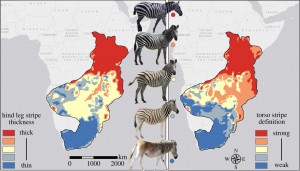Why is the sky blue? Why did the cheetah get all the speed? Why do zebras have stripes? These are all questions that we wonder about the world around us. Fortunately scientists are working on answers in regards to zebras and their magnificent stripes.
In the plains of Africa, striping varies regionally. In some areas zebras have thick black and white striping covering their entire body, while in other areas zebras have thin stripes, with some parts of the body having no striping at all. In the past, many ideas have been developed to explain why zebras have stripes and to explain the variation in their stripes. Perhaps their stripes make it difficult for predators to predict their size and speed, therefore protecting them from capture. Perhaps the stripes cause an optical illusion that confuses biting flies in their habitat. Perhaps their stripes evolved for thermoregulation (the process of cooling and heating the body to the correct temperature) or social unity.

Predicted levels of stripe thickness on hind leg (left) and torso stripe definition (right).
Image Courtesy of: Royal Society Publishing
Recent studies have found that the amount of striping on a zebra, and the intensity of that striping can be predicted by the temperature of the environment these zebras are living in. In hotter, drier areas, zebras have thicker stripes. Thinner stripes are seen farther from the tropics, in
slightly cooler areas. This pattern was seen on the torso, with the legs being a bit harder to predict.
This finding supports the thermoregulation hypothesis that states the thicker the stripes on the zebra, the more the heat difference between the black and white stripes. This causes eddies of air that have a cooling effect on the zebra’s body temperature.
Additionally, a non-contact thermometer gun was used to compare the surface body temperature of zebras with herbivores of approximately the same size in the same area. This non-contact thermometer gun is simply pointed at the animal, and then it takes a reading of the infrared energy emitted by the animal and the animal’s temperature can be determined. It was found that zebras had an average body temperature of 29.2◦C, which was significantly lower than herbivores of the same size with a body temperature of 32.5◦C.
This relationship between temperature and striping patterns on zebras gets us one step closer to determining the functionality of zebra stripes. However, the cause of the correlation between temperature and striping patterns is still not fully understood and further investigation is needed.
Posted by: Alex Ensing


4 responses to “The Mystery Of How The Zebra Got Its Stripes”